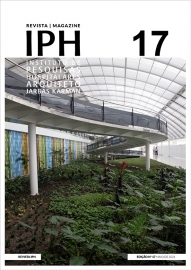Publications IPH Magazine Revista IPH Nº17 IPH Magazine #17

- IPH Magazine #17
- COVID-19 pandemic and the trends in healthcare design: insights from the "Decalogue for Resilient Hospitals"
- Healthcare closer to people: A qualitative study of a Swedish reform on healthcare delivery
- Spatial flexibility and extensibility in hospitals designed by João Filgueiras Lima
- Design Insights from a Research Initiative on Ambulatory Surgery Operating Rooms in the U.S.
- A study on the development of the concept growth and change on hospital architecture in Japan
- A study on hospital infection control through architecture in 1980: Chapecó Regional Hospital case study
- Natural ventilation for hospitalization environments: historical aspects
- Hospital architecture and its propositions for beginners and experts
IPH Magazine #17
Prof. Arq. Marcio Nascimento de Oliveira
It was with great pleasure that I accepted IPH's invitation to help organize the new issue of their magazine, a publication known for the quality of its contribution to the technical and scientifical knowledge concerning healthcare facilities. One of the late Jarbas Karman's main legacies, the IPH Magazine offers a priceless space for reflection and exchange of experiences among professionals, scholars, and researchers, serving as a true "platform engaged in disseminating ideas, research projects, innovations, projects and plans", as Karman himself described in his editorial for the first issue, published in February 2001.
Celebrating the twentieth anniversary of this successful journey, this 17th issue includes seven unpublished articles, with contributions from renowned professionals and invited researchers from Brazil, Japan, Sweden, Italy, and the United States, as well as papers submitted to the magazine's editorial team. This edition also includes the collaboration of Prof. Elza Costeira, who reviewed the recent edition of "Feitos para Curar - A arquitetura e o processo projetual no Brasil", a book written by architect Luiz Carlos Toledo, a must-read for everyone interested in hospital architecture.
From Toyo University, professor Kazuhiko Okamoto presents a study about the development of the concept Growth and Change, proposed by British architect John Weeks, in hospital architecture in Japan. In his study, Prof. Okamoto demonstrates how Weeks' theoretical approach related with and resonated among the existing practices in Japan from the end of the 60's and its influence in several Japanese hospital designs.
In another article, a group of researchers from Chalmers University of Technology presents a qualitative study concerning the outcomes of a reform carried out in the Swedish health system, which tried to achieve, through a strategy based on decentralization making "healthcare closer to people". The study presents an overview on the repercussions and tensions arising from the implementation of local hospitals and, more generally, other decentralized public services in the management of the healthcare network.
From Italy, researchers from the Polytechnic Institute of Milan discuss how COVID-19 pandemic has affected the tendencies in designing healthcare facilities, using as background the Decalogue for Resilient Hospitals, a study whose purpose was to indicate the main strategies to be considered when designing new hospitals and remodeling existing ones. By listing several strategies that can be used by designers, during both the hospital design and operations, researchers Stefano Capolongo, Marco Gola and Andrea Brambilla emphasize that the current pandemic has led to an extreme change in how healthcare services work, accelerating innovation and transformation processes.
For his contribution, architect and professor Haroldo Pinheiro presents a reflection on how the concepts of spatial flexibility and extensibility were applied on hospitals planned by João Filgueiras Lima, aka Lelé. From his experience gathered during the development of several projects when he teamed up with Lelé, Haroldo highlights the building elements and solutions from iconic designs for the Sarah Group, especially the units built in Brasília and Salvador (Brazil), enriching his text with historical details and valuable drawings and photographs from his personal collection.
From Clemson University (USA), researchers David Allison, Herminia Machry and Anjali Joseph present the outcomes of a study concerning the design of ambulatory operating rooms. Initially, they seek to map, through case studies and visits, potential flow disruptions and other interferences that may be a hazard for the numerous activities involved in the daily routine of such settings. The researchers then present the design process of an ambulatory OR prototype, a study centered on evidence-based design recommendations, computer-based simulations and lessons learned with a post-occupancy evaluation of existing facilities. The prototype development included high-fidelity mock-ups in an iterative process that started with designing, continued with production and, finally, went to a phase of redesigning. The study findings include several recommendations on the dimension and layout of ambulatory ORs.
Researchers Chayane Galvão and Jonathas Silva, from PUC Campinas, present a discussion concerning the architectural evolutions of healthcare settings regarding social, technological, and legislative influences, highlighting the design solutions aimed at the control of hospital infections. By reviewing Chapecó Regional Hospital design, desined by architect Irineu Breitman, the authors identified design elements adopted by the architect with the purpose of decreasing the dissemination of hospital-acquired infections.
Finally, the architect and researcher Katia Fugazza presents a historical overview of design solutions concerning natural ventilation within healthcare settings. Her study, which is a consequence from her master's dissertation, shows the timeline of natural ventilation solutions in hospital design throughout history, stressing its importance and illustrating with several examples of renowned designs.
We hope the variety and richness of topics presented in this issue of the IPH Magazine serve as more than just a source of research, but also as inspiration and encouragement for everyone currently or willing to work with technical-scientific production related to healthcare settings. This area's complexity and ever-growing technological evolution require constant new investigations and research and, after two decades of existence, the IPH Magazine reaffirms its commitment to keep its doors always open for imparting high-quality information.
Enjoy your reading!
Prof. Architect Marcio Nascimento de Oliveira
Send by e-mail:


